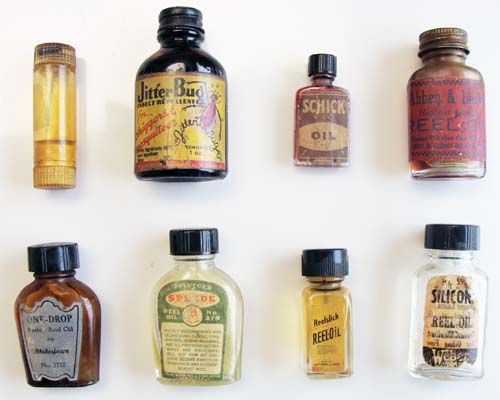I have been looking through old tackle boxes for thirty years. Many times I have been amazed by what one could read into the contents of a particular tackle box. Probably the person who has looked into more really early tackle boxes than anyone is know is long time collector Walter Blue. Walter lived in Kalamazoo Michigan and began looking for old tackle long before it became the popular hobby it is today. Walter held an annual garage sale in an attempt to get rid of the mountains of usable (but not quite collectible) tackle he accumulated. Walt separated items out to make it easier for the shopper to locate what he wanted. I remember large metal boxes that were brim full of metal spoons and were so heavy it was a real chore to move one. One box I recall was full of dozens of sharpening stones that had come from tackle boxes. There were many shapes and sizes. In the middle of these stones was one with a hole drilled in it. Having collected Indian artifacts for many years I recognized it as a perfect ancient Indian pendant made from Huronian banded slate. When I told Walt what it was he was somewhat shocked. I've often thought about the fellows who went fishing one day and found that artifact lying by the bank of a stream and threw it into their tackle box where it remained.

One very old box I found many years ago had only two, well-made “folk art” baits in it. Today they are in Carl White's book in the “unknown” section. What really made this box memorable was the rest of the contents. In the bottom were close to 40 whiskey corks. Cleverly hidden in the rest of the box's contents were several cork screws. My take on the box was that when this fellow went “fishing” he had a pint of whiskey with him and after rowing out of sight, he anchored and started to imbibe. When finished, he probably sunk the bottle in the lake, tossed the cork in the tackle box and went home to report to his wife that fishing had been slow. If she did suspect his real activities, there was little evidence to be found as most folks then used common corks for bobbers.

A common item found in older tackle boxes is insect repellent. It came with many names but most contained citronella in some form. I find the smell of this substance somewhat pleasant. It immediately brings back memories of my Grandfather's utility room where citronella's sweet oder always permeated the atmosphere. Some years ago I attended an estate auction where I bought a well stocked tackle box with many baits from the 1920's. The auction ended on a Saturday evening. The next day I had to leave early and would be gone for a week on business. As I would be in Cincinnati the following weekend, I planned to attend the NFLCC lure show in Blue Ash, Ohio. I took the tackle box with me, intending to sort through its contents when things slowed down at the show. Around mid morning at the show I pulled the box from underneath my table and began to examine my finds. In the bottom of the box was a small glass medicine bottle of the very old type which used corks. I read the well worn, hand typed label. It said,“Oil of Pennyroyal”. The substance was the color of dark blue ink and I assumed it must be some sort of insect repellent. I don't know if it really was “Oil of Pennyroyal” or for that matter what it was, but when the cork was removed I immediately knew that I had made a BIG mistake. I jammed the cork back in as quickly as possible but the damage was done. Fellow collectors parted like the Red Sea in front of Moses and within a minute or two vacated the show room. I went out a side door and found the nearest dumpster. At that point I was told that there should be no repeat of what had just happened. I still wonder what was really in that bottle!

I am sometimes asked what is the most memorable non-tackle item I have ever found in a tackle box. My all time favorite is a tin of Dr Cannon's Salve. It is not in great shape and it does not contain (as most old tins in tackle boxes) hooks, sinkers or small spinners. What is great about this item is the write-up on the bottom of the tin. I have enlarged it here so you can read the entire description of its uses. It makes one wonder why so much time and money are put into medical research when Dr. Cannon discovered a cure for everything many years ago! LOL.

Tight Lines,
Wild Bill Sonnett
2 comments:
I do believe we have a dowmetal canoe and would like to find out somemore information on it. It has been in our family since the 1950's. Any information would help. Thank you Susan M Pflanz, roostlake1@gmail.com,
Susan I know nothing more than was presented with the ad. I have spoken to many canoe enthusiast and no one has ever heard of the canoe in question.
Bill Sonnett
Post a Comment